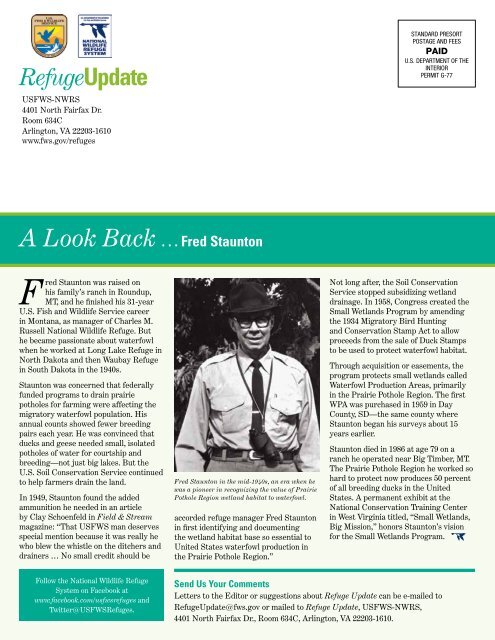Refuge Update - U.S. Fish and Wildlife Service
Refuge Update - U.S. Fish and Wildlife Service
Refuge Update - U.S. Fish and Wildlife Service
Create successful ePaper yourself
Turn your PDF publications into a flip-book with our unique Google optimized e-Paper software.
<strong>Refuge</strong><strong>Update</strong><br />
USFWS-NWRS<br />
4401 North Fairfax Dr.<br />
Room 634C<br />
Arlington, VA 22203-1610<br />
www.fws.gov/refuges<br />
A Look Back . . . Fred Staunton<br />
Fred Staunton was raised on<br />
his family’s ranch in Roundup,<br />
MT, <strong>and</strong> he finished his 31-year<br />
U.S. <strong>Fish</strong> <strong>and</strong> <strong>Wildlife</strong> <strong>Service</strong> career<br />
in Montana, as manager of Charles M.<br />
Russell National <strong>Wildlife</strong> <strong>Refuge</strong>. But<br />
he became passionate about waterfowl<br />
when he worked at Long Lake <strong>Refuge</strong> in<br />
North Dakota <strong>and</strong> then Waubay <strong>Refuge</strong><br />
in South Dakota in the 1940s.<br />
Staunton was concerned that federally<br />
funded programs to drain prairie<br />
potholes for farming were affecting the<br />
migratory waterfowl population. His<br />
annual counts showed fewer breeding<br />
pairs each year. He was convinced that<br />
ducks <strong>and</strong> geese needed small, isolated<br />
potholes of water for courtship <strong>and</strong><br />
breeding—not just big lakes. But the<br />
U.S. Soil Conservation <strong>Service</strong> continued<br />
to help farmers drain the l<strong>and</strong>.<br />
In 1949, Staunton found the added<br />
ammunition he needed in an article<br />
by Clay Schoenfeld in Field & Stream<br />
magazine: “That USFWS man deserves<br />
special mention because it was really he<br />
who blew the whistle on the ditchers <strong>and</strong><br />
drainers … No small credit should be<br />
Follow the National <strong>Wildlife</strong> <strong>Refuge</strong><br />
System on Facebook at<br />
www.facebook.com/usfwsrefuges <strong>and</strong><br />
Twitter@USFWS<strong>Refuge</strong>s.<br />
Fred Staunton in the mid-1940s, an era when he<br />
was a pioneer in recognizing the value of Prairie<br />
Pothole Region wetl<strong>and</strong> habitat to waterfowl.<br />
accorded refuge manager Fred Staunton<br />
in first identifying <strong>and</strong> documenting<br />
the wetl<strong>and</strong> habitat base so essential to<br />
United States waterfowl production in<br />
the Prairie Pothole Region.”<br />
STANDARD PRESORT<br />
POSTAGE AND FEES<br />
PAID<br />
U.S. DEPARTMENT OF THE<br />
INTERIOR<br />
PERMIT G-77<br />
Not long after, the Soil Conservation<br />
<strong>Service</strong> stopped subsidizing wetl<strong>and</strong><br />
drainage. In 1958, Congress created the<br />
Small Wetl<strong>and</strong>s Program by amending<br />
the 1934 Migratory Bird Hunting<br />
<strong>and</strong> Conservation Stamp Act to allow<br />
proceeds from the sale of Duck Stamps<br />
to be used to protect waterfowl habitat.<br />
Through acquisition or easements, the<br />
program protects small wetl<strong>and</strong>s called<br />
Waterfowl Production Areas, primarily<br />
in the Prairie Pothole Region. The first<br />
WPA was purchased in 1959 in Day<br />
County, SD—the same county where<br />
Staunton began his surveys about 15<br />
years earlier.<br />
Staunton died in 1986 at age 79 on a<br />
ranch he operated near Big Timber, MT.<br />
The Prairie Pothole Region he worked so<br />
hard to protect now produces 50 percent<br />
of all breeding ducks in the United<br />
States. A permanent exhibit at the<br />
National Conservation Training Center<br />
in West Virginia titled, “Small Wetl<strong>and</strong>s,<br />
Big Mission,” honors Staunton’s vision<br />
for the Small Wetl<strong>and</strong>s Program.<br />
Send Us Your Comments<br />
Letters to the Editor or suggestions about <strong>Refuge</strong> <strong>Update</strong> can be e-mailed to<br />
<strong>Refuge</strong><strong>Update</strong>@fws.gov or mailed to <strong>Refuge</strong> <strong>Update</strong>, USFWS-NWRS,<br />
4401 North Fairfax Dr., Room 634C, Arlington, VA 22203-1610.

















